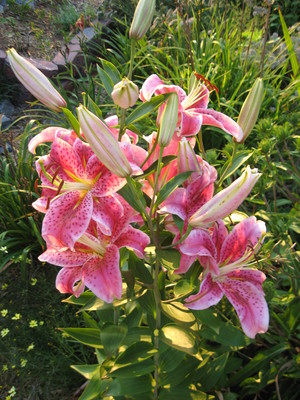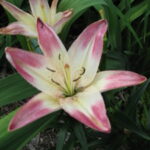If you, like me, are drawn to lilies, you will find yourself irresistibly drawn to the Oriental lily. This hybrid is often confused with another hybrid lily – the Asiatic lily. There are distinct differences, however; although, the Oriental lily does have one thing in common with the Asiatic lily. The Oriental is a lily that you will want to add to your perennial garden.
The Oriental lily resulted mainly from a cross between two Japanese species of lilies – Lilium auratum (a true lily that is white with gold radial markings) and Lilium speciosum (also called the ‘Japanese lily’ and is white to pink with a strong fragrance). These two species were difficult to cross; however, Francis Parkman, an American historian and horticulturalist, managed to do so in 1869. About one hundred years later, a similar hybridization was accomplished by two New Zealanders named J.S. Yeates and Leslie Jury. Yeates, a professor at Massey University, was the driving force behind this effort, with his most famous cultivar being ‘Journey’s End,’ which looks very similar to the ‘Star Gazer’ Oriental lily. (It should also be noted that Yeates was the first to breed dwarf Oriental lilies.) Yeates and Jury sent many of their cultivars to Jan de Graaf at the famous Oregon Bulb Farms, which stimulated the development of Oriental lily hybrids in the United States. These cultivars also became a part of de Graaf’s ‘Imperial’ series, as well as, his ‘Empress’ series of Oriental lilies. Hybridization of Oriental lilies really took off when the American Leslie Woodriff of the Sun Valley Group in California, introduced the first upward-facing Oriental lily in 1974, which he named ‘Star Gazer.’ ‘Star Gazer’ quickly became the most popular of all the Oriental lilies and much loved as a cut flower.
As previously mentioned, Oriental lilies and Asiatic lilies are often mistaken for one another. Both have bowl-shaped, flat, or re-flexed blooms that are upright, outward-facing, or pendant; however, the Orientals sometimes have frilly blooms, as well. Oriental lilies, also, grow to be much taller than Asiatics – actually reaching heights of 6-feet. Orientals are, in addition, very fragrant, while Asiatics have absolutely no scent.
Plant your Oriental lily in a sunny location in well-drained, humus-rich soil. Lilies, while being sun-worshippers, do tend to like their roots to be cool. This means you should plant them among other perennials, which can provide some shade for the roots of your Oriental lilies. Also, as with all lilies, do not be so quick to cut back the stems once the blooms are spent. Let the leaves and stems die back naturally, which will allow the bulbs to store nutrients for the next year’s growing season. (I will plant vines at the base of my Oriental lily so that the vine can twine up the stem of the lily, thereby hiding the not-so-pretty dying leaves.)
I have heard some gardeners say that these lilies do not do well in very hot, humid climates. I live in Northeast Tennessee (Zone 6), where it can get both hot and very humid. My Oriental lilies do extremely well. Just make sure, as in any humid area, that they have good air circulation. Also, be sure to mulch well in the fall.
Do not shy away from including lilies in your landscape. The Oriental lily, with its large, showy blooms, will make quite an impression.
Try some of these cultivars in your garden:
1.’Star Gazer’ (deep pink with white and probably the most popular of all the Oriental lilies)
2.’Casa Blanca’ (white, sometimes showing frilly blooms)
3.’Rosie Wonder’ (white with a pink wash)
4.’Miss Lucy’ (pink double Oriental lily)
5.’Salmon Star’ (peachy-color)
For examples of more Asiatic lilies, see:
Van Bourgondien
Anne M. Hanchek and Jane E. Bolla revised by Deborah Brown, November, 2004 Selecting Lilies for Your Garden
Also of interest: McGeorge, Pamela. Lilies. New Zealand: Firefly Books Ltd., 2004.
To see some of the lilies in my garden, visit: Dena’s Garden


